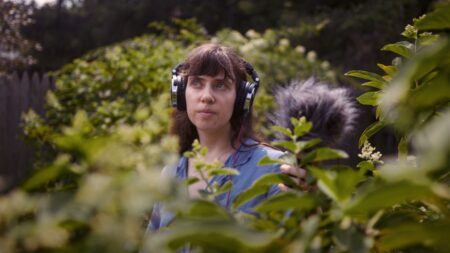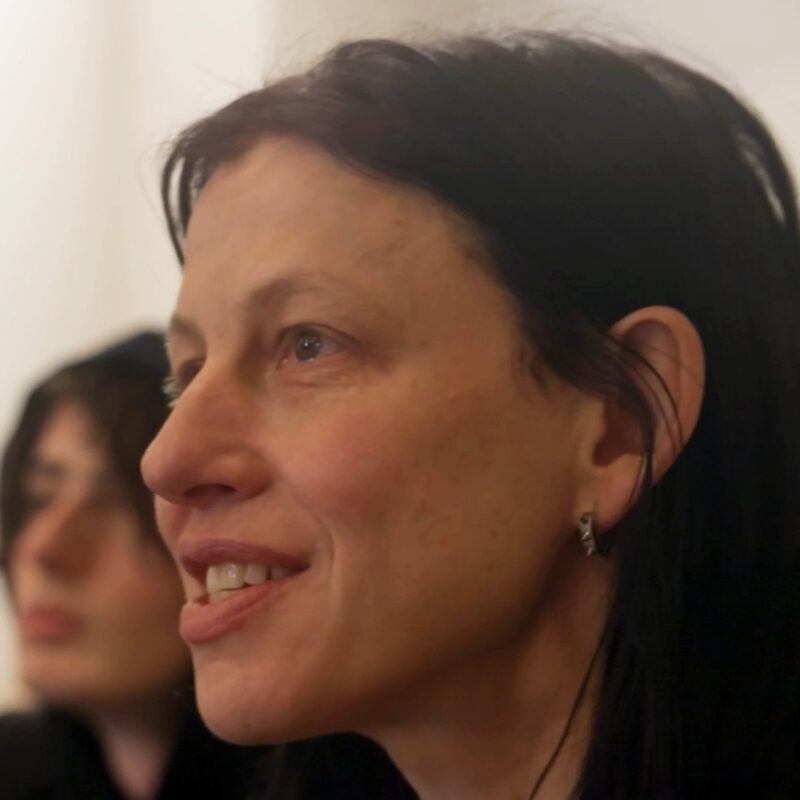Continue playing
(Time remaining: )
Play from beginning
Continue playing "{{ controller.videos[controller.getVideo(controller.currentVideo)].segmentParentTitle}}"
{{controller.videos[controller.getVideo(controller.currentVideo)].title}} has ended.
DOOMAnne Imhof
Transforming the Park Avenue Armory’s Drill Hall into a prom-decorated gymnasium filled with streamers, balloons, and Cadillac Escalades, artist Anne Imhof stages Romeo and Juliet in reverse for her three-hour immersive work of dance, music, skateboarding, and more, DOOM: House of Hope (2025). This documentary short captures Imhof as she creates her largest work to date, from the play and experimentation of the rehearsal room to the excitement and energy of performance. Always destabilizing genre, medium, and discipline, the artist brings together elements from the classical to the contemporary to explore youth, art criticism, and more. While preparing for DOOM, Imhof mounts her 2024 exhibition Wish You Were Gay, where she displays early video works alongside new sculptures and paintings exploring her own youth and offering deeper insight into what inspired DOOM. “DOOM was telling the story of these wounds,” says the artist. “In my case, the wound was shaped into a diamond. I felt this art was this valuable thing in me that I could use, but the shaping wasn’t always easy.”
This film was directed by Ian Forster, edited by Winnie Cheung and Mary Ann Toman, and filmed by Jarred Alterman, Christoph Lerch, and Hunter Zimny.
Credits
Director: Ian Forster. Executive Producer: Tina Kukielski. Series Producer: Ian Forster. Editors: Winnie Cheung & Mary Ann Toman. Cinematography: Jarred Alterman, Christoph Lerch & Hunter Zimny. Sound: Teresa-Esmeralda Sanchez & Jay Villas Boas. Colorist: Marika Litz. Sound Mix: Collin Blendell. Associate Producer: Andrea Chung. Associate Curator: Jurrell Lewis. Assistant Editors: Stephanie Cen & Michelle Hanks.
Artwork Courtesy: Anne Imhof & Sprüth Magers
Special Thanks: Klaus Biesenbach, Kunsthaus Bregenz, Park Avenue Armory, Estella Sirotta & Tom Trayer.
Piano & Composition: Eliza Douglas, Jakob Eilinghoff, Ville Haimala, Jacob Madden, Talia Ryder, Levi Strasser, Arthur Tendeng & Lia Wang.
“DOOM: House of Hope” Company: Eva Alt, Jacqueline Bologna, Sharleen Chidiac, Efron Danzig, Xavier Days, Michael de la Nuez, Eliza Douglas, Henry Douglas, Jakob Eilinghoff, Joe Endo, Vinson Fraley, Coco Gordon Moore, Perla Haney-Jardine, Connor Holloway, Josh Johnson, Eva Bella Kaufman, Tenaya Kelleher, Toon Lobach, Judea Lowe, Jacob Madden, Tyler Maloney, Cranston Mills, Tahlil Myth, Jeremy “OPT” Perez, Tess Petronio, Sharon Rapolla, Talia Ryder, Sihana Shalaj, Jourdynn Sherman, Daniil Simkin, Levi Strasser, Desean Taber, Arthur Tendeng, Devon Teuscher, Dean Violante, Casper von Bülow, Lia Wang, Akobi Williams, Remy Young.
Extended Play is made possible with support from The Andy Warhol Foundation for the Visual Arts, the Art21 Contemporary Council, public funds from the New York City Department of Cultural Affairs in partnership with the City Council, the New York State Council on the Arts with the support of the Office of the Governor and the New York State Legislature, the Every Page Foundation, and the Henry Nias Foundation.
Closed captionsAvailable in English, German, Romanian, Italian, Japanese, Korean, Chinese, Italian
Through the Art21 Translation Project, multilingual audiences from around the globe can contribute translations, making Art21 films more accessible worldwide. Translate this video now.
Interested in showing this film in an exhibition or public screening? To license this video please visit Licensing & Reproduction.
Anne Imhof, born in 1978 in Giessen, Germany, and lives and works between Berlin and New York City. She earned her BA from the University of Art and Design, Offenbach in 2003, and her MFA from the State Academy of Fine Arts, Städelschule, Frankfurt a.M. in 2012. Imhof uses performance, sculpture, painting, drawing, installation, and music to examine the codes of cultural identities and social hierarchies. Through her practice, she explores themes of belonging, spectatorship, and alienation while heightening the everyday performance of self, subculture, and identity.
“‘Doom’ is a word I wanted to use in a juxtaposition of the word ‘hope.’ For me, it was interesting that everybody could play Juliet and everybody could play Romeo, and I could make a statement about the way I think love should be free and beautiful in whatever shape and form. We own the idea of a free being and a free will, and are able to express that.”
Anne Imhof

